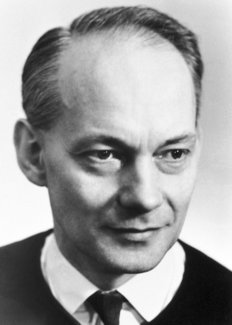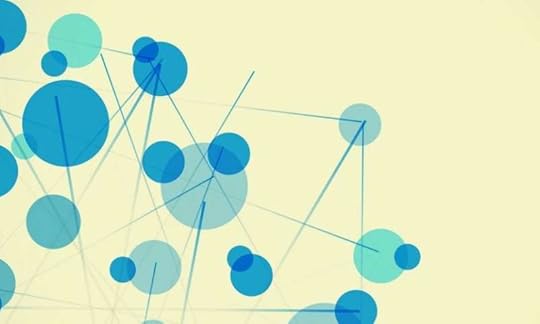Michael J. Behe's Blog, page 517
March 1, 2019
Logic and First Principles, 12: The crooked yardstick vs plumb-line self-evident truths
Let’s propose a silly example, that a certain Emperor (maybe, just before he went out in his new invisible clothes) decides that a certain crooked stick is now the standard of length, straightness, uprightness and accuracy, a crooked yardstick. Suddenly, what is genuinely such things will be deemed the opposite. And then, suppose that somehow he and his publicists persuade the general public to accept the new standard. Will they not then find that those backward fuddy duddies that hold up their old yardsticks are ignoramuses and obstacles to progress and harmony?
Are we then locked into a war of competing imposed definitions and redefinitions? (That would for sure be a manipulator’s paradise.)
That’s where a plumb-line might help:
 A plumb-line
A plumb-lineHere, we see something that is naturally straight and upright, which will then clearly correct the crooked yardstick. It will even vindicate the fuddy duddies, even though the progressives won’t like it.
So, now, let us lay on the table a key concept: there are self-evident first truths (including inescapably true claims) that can and do serve as plumb-line tests for various truth claims. And thus, such truths can allow us to sift through various worldview or ideological alternatives and schools of thought. Which then allows us to think, decide and act with greater soundness.
For simple example the Josiah Royce proposition, E = error exists, is undeniably true. To see that, try to deny it, ~E. That in effect claims it is error to propose E. So E must be true.
Is this a trivial result?
No, as E is an example of self-evident truth, of truth, of objectively warranted truth (thus knowledge), indeed of truth warranted to undeniable certainty (thus certain knowledge). Such immediately sweeps away radical skepticism, relativism and subjectivism, as well as a raft of linked common notions.
Likewise, for any distinct A — say, a bright red ball on a table — we see that the world can be dichotomised W = {A|~A} thus showing the triple first principles of right reason, Identity, Non Contradiction and Excluded Middle:

Here, A is itself in light of its particular distinct characteristics. No x in W can be both A and ~A. Any x in W will be A or else ~A. These laws are inescapably certain, indeed, any argument to object to them must rely on distinct identity and its corollaries to make an intelligible point. A classic case in point is a remark by St Paul:
1 Cor 14: 7 Yet even lifeless things, whether flute or harp, when producing a sound, if they do not produce distinct [musical] tones, how will anyone [listening] know what is piped or played? 8 And if the [war] bugle produces an indistinct sound, who will prepare himself for battle? 9 So it is with you, if you speak words [in an unknown tongue] that are not intelligible and clear, how will anyone understand what you are saying? You will be talking into the air [wasting your breath]! [AMP]
This is again, hardly a trivial result. Ever so much of the modern skepticism towards reasoned thought pivots on dismissiveness towards precisely these three laws of thought. Where, BTW, Quantum Physicists rely on just these laws in order to do their work.
Similarly, if we look at the world partition W = {A|~A} we see that A is itself, a unit distinctly different from the complex unity ~A, thus we find unity and duality. Where too the partition is empty and there is nothing in W but outside A and ~A, thus, nullity. This sets up the natural numbers, integers, rationals, reals, continuum, and even by using vector rotation, complex numbers. That is a non-trivial consequence.
Likewise, identity and the logic of being allow us to see how inductive reasoning and causality can be grounded.
So, too, as arguably there are self-evident, plumb-line moral truths, moral forms of radical skepticism, relativism and subjectivism, as well as a raft of linked common notions are also swept away. This re-opens the issue of intelligible laws of our morally governed nature, framing thought, speech, behaviour and law. Indeed, Cicero is back:
—Marcus [in de Legibus, introductory remarks,. C1 BC]: . . . the subject of our present discussion . . . comprehends the universal principles of equity and law. In such a discussion therefore on the great moral law of nature, the practice of the civil law can occupy but an insignificant and subordinate station. For according to our idea, we shall have to explain the true nature of moral justice, which is congenial and correspondent [36]with the true nature of man. We shall have to examine those principles of legislation by which all political states should be governed. And last of all, shall we have to speak of those laws and customs which are framed for the use and convenience of particular peoples, which regulate the civic and municipal affairs of the citizens, and which are known by the title of civil laws.
Quintus [his real-life brother]. —You take a noble view of the subject, my brother, and go to the fountain–head of moral truth, in order to throw light on the whole science of jurisprudence: while those who confine their legal studies to the civil law too often grow less familiar with the arts of justice than with those of litigation.
Marcus. —Your observation, my Quintus, is not quite correct. It is not so much the science of law that produces litigation, as the ignorance of it, (potius ignoratio juris litigiosa est quam scientia) . . . . With respect to the true principle of justice, many learned men have maintained that it springs from Law. I hardly know if their opinion be not correct, at least, according to their own definition; for “Law (say they) is the highest reason, implanted in nature, which prescribes those things which ought to be done, and forbids the contrary.” This, they think, is apparent from the converse of the proposition; because this same reason, when it [37]is confirmed and established in men’s minds, is the law of all their actions. They therefore conceive that the voice of conscience is a law, that moral prudence is a law, whose operation is to urge us to good actions, and restrain us from evil ones. They think, too, that the Greek name for law (NOMOS), which is derived from NEMO, to distribute, implies the very nature of the thing, that is, to give every man his due. [–> this implies a definition of justice as the due balance of rights, freedoms and responsibilities] For my part, I imagine that the moral essence of law is better expressed by its Latin name, (lex), which conveys the idea of selection or discrimination. According to the Greeks, therefore, the name of law implies an equitable distribution of goods: according to the Romans, an equitable discrimination between good and evil. The true definition of law should, however, include both these characteristics. And this being granted as an almost self–evident proposition, the origin of justice is to be sought in the divine law of eternal and immutable morality. This indeed is the true energy of nature, the very soul and essence of wisdom, the test of virtue and vice.
So, then, are we willing to acknowledge the problem of crooked yardsticks and the value of plumb-line, self-evident truths in our thinking, arguing, deciding and doing? END
Copyright © 2019 Uncommon Descent . This Feed is for personal non-commercial use only. If you are not reading this material in your news aggregator, the site you are looking at is guilty of copyright infringement UNLESS EXPLICIT PERMISSION OTHERWISE HAS BEEN GIVEN. Please contact legal@uncommondescent.com so we can take legal action immediately.
Plugin by Taragana
February 28, 2019
Chemist Manfred Eigen (1927–2019) dies
 Manfred Eigen, 1967
Manfred Eigen, 1967A Nobelist (1967), he was among other things an origin-of-life chemist and in that capacity he authored Eigen’s paradox:
His success made it possible for scientists to study reactions catalysed by enzymes that drive all processes of life. Eigen developed concepts to explain how replicating macromolecules on the prebiotic Earth might have evolved into replicating organisms. In 1971, for example, he posed the paradox that without error-correction enzymes, the length of a nucleic acid would be limited because, in larger molecules, mutations would destroy the information content of subsequent generations. But this maximum size (or error threshold) was too small to encode an error-correcting enzyme. Eigen’s paradox still challenges theoretical biologists. Georgina Ferry, “Manfred Eigen (1927–2019)” at Nature
Here’s an article on Eigen’s paradox:
If we wanted longer, self-sustainable RNA molecules we would need better fidelity. But better fidelity can only be achieved with the help of specialized enzymes. But the smallest genome able to code for such an enzyme, and for the necessary translating machinery, would require a number of bases greatly exceeding 100 nucleotides. It’s a catch-22 situation.
Eigen speculates that the small molecules would have to somehow cooperate (Lo, a coordination problem!) to create a system capable of holding enough information to create more complex stuff… Martin Sustrik, “Coordination Problems in Evolution: Eigen’s Paradox” at LESSWRONG (2018)
Also a paper on the paradox (paywall).
See also: Origin Of Life: Christian Scientific Society Meeting March 10-11 In LA
and
“Super-Ancient Mobile Organisms” Push Mobile Life Back To 2.1 Billion Years Ago
Follow UD News at Twitter!
Copyright © 2019 Uncommon Descent . This Feed is for personal non-commercial use only. If you are not reading this material in your news aggregator, the site you are looking at is guilty of copyright infringement UNLESS EXPLICIT PERMISSION OTHERWISE HAS BEEN GIVEN. Please contact legal@uncommondescent.com so we can take legal action immediately.Plugin by Taragana
A new approach to probability?

Three approaches are analysed—frequencies, propensities or degrees of belief, and a fourth is proposed, degree of support:
… our four theories offer divergent advice on how to figure out the values of probabilities. The first three interpretations (frequency, propensity and confidence) try to make probabilities things we can observe – through counting, experimentation or introspection. By contrast, degrees of support seem to be what philosophers call ‘abstract entities’ – neither in the world nor in our minds. While we know that a coin is symmetrical by observation, we know that the proposition ‘this coin is symmetrical’ supports the propositions ‘this coin lands heads’ and ‘this coin lands tails’ to equal degrees in the same way we know that ‘this coin lands heads’ entails ‘this coin lands heads or tails’: by thinking. Nevin Climenhaga, “The concept of probability is not as simple as you think” at Aeon
Hmmm. “Thinking” is a risky strategy suggestion in a world where consciousness is supposed to be an illusion or else a material thing —unless, of course, your coffee mug has it too.
No legerdemain around probability is going to make most naturalism (nature is all there is, often called “materialism) claims true. But not for lack of trying.
See also: Probability of a single protein forming by chance
and
Confusing Probability: The “Every-Sequence-Is-Equally-Improbable” Argument
Follow UD News at Twitter!
Copyright © 2019 Uncommon Descent . This Feed is for personal non-commercial use only. If you are not reading this material in your news aggregator, the site you are looking at is guilty of copyright infringement UNLESS EXPLICIT PERMISSION OTHERWISE HAS BEEN GIVEN. Please contact legal@uncommondescent.com so we can take legal action immediately.
Plugin by Taragana
Gaming the Science system: How replication can be gamed in neuroimaging

Following on fact that many anchor social science findings have not been replicated, we now hear from a new paper that “the way imaging results are currently analysed ‘allows presenting anything as a replicated finding.’” :
The provocative argument is put forward by YongWook Hong from Sungkyunkwan University in South Korea and colleagues, in a preprint posted recently to bioRxiv. The fundamental problem, say the researchers, is that scientists conducting neuroimaging research tend to make and test hypotheses with reference to large brain structures. Yet neuroimaging techniques, particularly functional magnetic resonance imaging (fMRI), gather data at a much more fine-grained resolution.
This means that strikingly different patterns of brain activity could produce what appears to be the same result. For example, one lab might find that a face recognition task activates the amygdala (a structure found on each side of the brain that’s involved in emotional processing). Later, another lab apparently replicates this finding, showing activation in the same structure during the same task. But the amygdala contains hundreds of individual “voxels”, the three-dimensional pixels that form the basic unit of fMRI data. So the second lab could have found activity in a completely different part of the amygdala, yet it would appear that they had replicated the original result. Matthew Warren, “Widely Used Neuroimaging Analyses Allow Almost Any Result To Be Presented As A Successful Replication, Paper Claims” at BPS Digest
They tested that and came up with some dramatic variances. Remember that when you hear what neuroimaging supposedly shows about how people think.
Paper. (open access)
See also: “Motivated reasoning” defacing thes ocial sciences?
At the New York Times: Defending the failures of social science to be science Okay. So if we think that — in principle — such a field is always too infested by politics to be seriously considered a science, we’re “anti-science”? There’s something wrong with preferring to support sciences that aren’t such a laughingstock? Fine. The rest of us will own that and be proud.
What’s wrong with social psychology , in a nutshell
How political bias affects social science research
Stanford Prison Experiment findings a “sham” – but how much of social psychology is legitimate anyway?
A BS detector for the social sciences
All sides agree: progressive politics is strangling social sciences
and
Back to school briefing: Seven myths of social psychology: Many lecture room icons from decades past are looking tarnished now. (That was 2014 and it has gotten worse since.)
Follow UD News at Twitter!
Copyright © 2019 Uncommon Descent . This Feed is for personal non-commercial use only. If you are not reading this material in your news aggregator, the site you are looking at is guilty of copyright infringement UNLESS EXPLICIT PERMISSION OTHERWISE HAS BEEN GIVEN. Please contact legal@uncommondescent.com so we can take legal action immediately.
Plugin by Taragana
Darwinian cheating story about birds not confirmed

Crotophaga major (Greater Ani)/Arthur Chapman (CC BY 2.0)
One Darwinian claim is that some species of birds lay their eggs in other birds’ nests because they gain a fitness advantage by doing so. They spread their selfish genes with less effort. Never mind the real possibility is that these species have simply lost track of how to make a nest and are coping successfully with that fact by laying eggs in another species’ nest. Anyway, given that these species don’t (can’t?) make nests, how would we test the proposition that they are better off not doing so?
One Panama cuckoo, the greater ani, makes nests, usually in a colony of male-female pairs. But some females who have lost their eggs and nests to predators sneak to other nests to lay eggs. What happens then?
Mothers that parasitize other nests in this way seem to lay more eggs a year, on average, Riehl says. “It’s actually kind of hard to be a parasite,” she says. But the average number of chicks that survived to flutter out of the nest on their own frantic wing power was about the same for all females, Riehl and Princeton colleague Meghan Strong report online February 27 in Nature. The mothers that always cooperated averaged about one fledgling a year, and so did the females that laid stealth eggs…
The cheaters tend to repeat their deception if disaster strikes them again. Finding individual birds with a tendency to cheat could be “step one,” Riehl says, to testing for some heritable genetic basis for sneaking eggs. Susan Milius, “This parasitic cuckoo bird shows cheaters don’t always get ahead” at Science News
So the strategy is not outstandingly successful and the researchers are now looking for an explanation other than a selective advantage. That’s wise on their part. This sounds like another strategy where the bird merely adapts; sometimes it works and sometimes it doesn’t. No big Darwin theory is needed.
But maybe findings don’t really matter much yet, no matter how frequent the finding or how strong the signal. We will still hear the Darwinian myths in schools and traditional media. If you want more Darwinian myths, we can talk about peacocks, for example, or why stressed mares miscarry (going full Darwin).
See also: Sexual trappings (dimorphism) may increase the likelihood of extinction, not survival (peacocks)
and
Why stressed mares miscarry
Follow UD News at Twitter!
Copyright © 2019 Uncommon Descent . This Feed is for personal non-commercial use only. If you are not reading this material in your news aggregator, the site you are looking at is guilty of copyright infringement UNLESS EXPLICIT PERMISSION OTHERWISE HAS BEEN GIVEN. Please contact legal@uncommondescent.com so we can take legal action immediately.
Plugin by Taragana
February 27, 2019
Steve Meyer: What is intelligent design?
Steve Meyer is the author of Darwin’s Doubt
Hat tip: Philip Cunningham
See also: A free discussion guide to Darwin’s Doubt
Copyright © 2019 Uncommon Descent . This Feed is for personal non-commercial use only. If you are not reading this material in your news aggregator, the site you are looking at is guilty of copyright infringement UNLESS EXPLICIT PERMISSION OTHERWISE HAS BEEN GIVEN. Please contact legal@uncommondescent.com so we can take legal action immediately.
Plugin by Taragana
NASA recreates the origin of life and it’s totally shocking
In the plain Jane story, NASA is studying the origin of life in order to narrow down where to look for it off the planet. But then we read:
A new NASA study has recreated the origins of life, building the ocean’s floors from 4 billion years ago as humanity attempts to understand how life started on Earth and where else it might be found.
The study, conducted by astrobiologists at NASA’s Jet Propulsion Laboratory (JPL) and published in Proceedings of the National Academy of Sciences, looks at how life began in hydrothermal vents on the ocean floor. …
While it’s important to note NASA has not created life itself in the experiment, it does raise the possibility that the hydrothermal vents could appear elsewhere in the universe and be a building block for life.
“If we have these hydrothermal vents here on Earth, possibly similar reactions could occur on other planets,” said JPL’s Erika Flores, co-author of the new study … Chris Ciacia, “NASA was able to recreate the ‘origins of life’ and the results are shocking” at [publication]
What’s shocking is the hype. Essentially, the team created some amino acids and “Some researchers believe these could combine (like Legos) and create further complex molecules which could then be a precursor to life.”
As a friend said: Oh.
Another friend wonders whether science news is now neck and neck with Daytime TV.
No wonder some software firms are developing AI to write news stories. Critical thinking is not sought in either the writer or the reader so it’s all good, right?
Paper. (paywall)
See also: NASA is investing more in prebiotic chemistry (Suzan Mazur interview)
and
Origin of life: Could it all have come together in one very special place?
Follow UD News at Twitter!
Copyright © 2019 Uncommon Descent . This Feed is for personal non-commercial use only. If you are not reading this material in your news aggregator, the site you are looking at is guilty of copyright infringement UNLESS EXPLICIT PERMISSION OTHERWISE HAS BEEN GIVEN. Please contact legal@uncommondescent.com so we can take legal action immediately.
Plugin by Taragana
Researchers: “profound yet intuitive: Every species has evolved backup plans”
 artist’s conception of the interactome/Shuoshu, iStock
artist’s conception of the interactome/Shuoshu, iStockTo study this “interactome,” researchers collecting data on 9 million protein interactions among species:
The scientists studied 1,840 species – from bacteria to primates – to understand how evolution built life forms that could survive in the face of natural adversities. What they discovered was profound yet intuitive: Every species has evolved backup plans that allow its protein machinery to find bypasses and workarounds when nature tries to gum up the works. No previous study has ever surveyed such a broad swath of species to find a survival strategy common to all life: Develop a versatile and robust molecular machinery.
“Across our entire sample, we find that the resilience of a species is strongly correlated with having protein networks that are robust to failure and can interact in multiple ways to preserve life,” said Stanford computer scientist Jure Leskovec, senior author of the paper that appears today in Proceedings of the National Academy of Sciences.
Evolutionary biologist Marcus Feldman, a co-author on the paper, said this is the most ambitious effort yet to understand what scientists call the interactome – the sum total of all the protein interactions for each species, just as genome describes the sum total of a species’ DNA. “We’re looking at the mechanism of evolution on an unprecedented scale, using the tools of data science to study the structure of the protein networks that make life possible,” Feldman said. Tom Abate, “Species evolve ways to back up life’s machinery” at Phys.org
And it all just happened, due to natural selection acting on random mutations (Darwinism), right? Look around you and you will see rocks slowly evolving into horses, using the same randomness…
Before you go: “Interspecies communication” strategy between gut bacteria and mammalian hosts’ genes described
Researchers: Cells Have A Repair Crew That Fixes Local Leaks
Researchers: How The Immune System “Thinks”
Follow UD News at Twitter!
Researcher: Mathematics Sheds Light On “Unfathomably Complex” Cellular Thinking
How do cells in the body know where they are supposed to be?
Researchers A Kill Cancer Code Is Embedded in Every Cell
How Do Cells Interpret The “Dizzying” Communications Pathways In Multicellular Life Forms?
and
Cell atlases reveal extreme complexity at biology’s frontiers
Follow UD News at Twitter!
Copyright © 2019 Uncommon Descent . This Feed is for personal non-commercial use only. If you are not reading this material in your news aggregator, the site you are looking at is guilty of copyright infringement UNLESS EXPLICIT PERMISSION OTHERWISE HAS BEEN GIVEN. Please contact legal@uncommondescent.com so we can take legal action immediately.
Plugin by Taragana
Why can top scientists get away with extraordinary claims?
 Artist’s impression of interstellar asteroid/comet, Oumuamua /ESO, M. Kornmesser
Artist’s impression of interstellar asteroid/comet, Oumuamua /ESO, M. KornmesserSpace object Oumuamua was rushed into the limelight as an extraterrestrial light sail. Seems odd to be in such a hurry:
Hype in science can be seen as an outgrowth of the larger crisis in journalism, as the precipitous decline in journalism jobs has meant that few news outlets employ dedicated science journalists. While many scientists blame hyped-up science news on a lack of journalistic expertise, the reality is more complex: As the bottom fell out for science journalism jobs, many science journalists were faced with the choice between battling it out as freelancers or using their skills to work in the communications offices of the institutions housing scientists — usually universities.
So the National Hush Hush went mainstream.
Over at the Atlantic, Marina Koren has written about how institutional prestige — in this case, Loeb’s position as chairman of the Harvard Astronomy Department, along with his long list of other accomplishments — can add a certain gravitas to a claim that might be dismissed if it came from somewhere else. But it also shapes who can get away with extreme ideas in the first place. Pushing the boundaries of plausibility comes with risk to one’s career and reputation, so while anyone can use hyperbole as a tool, the risk that one bears is substantially higher if you are not insulated by a name-brand institution, along with titles and accomplishments from adjacent name-brand institutions. Outlandish claims are, in some sense, a luxury concentrated in the hands of those who already possess other luxuries — a kind of academic weight whose heft accumulates with time. Lucianne Walkowicz, “Why scientists sometimes make extraordinary claims” at Washington Post
These are all tales of an invented god, of course.
The opinion piece is basically an extended defense of the kind of atmosphere in which the most ridiculous claims for Darwinism, for example, flourish and any questioners had better be careful. There is a lot of that out there in many areas now and the faithful are continually exhorted all the more to trust science, whether it’s sense or nonsense.
Hat tip: Ken Francis, co-author with Theodore Dalrymple of The Terror of Existence: From Ecclesiastes to Theatre of the Absurd.
Note: A book on the new pop science religion might well be titled “Tales of an Invented God.” An author would likely be challenged to keep up with all the non-events breathlessly documented in both AI and ET and their merger in the extraterrestrial cyborg. After all, the technocrats who invent their future gods can change, re-envision, replace, upgrade, eliminate them at any time.
See also: Astronomers: Solar System Object In Transit, Oumuamua, Might Be A “Light Sail Of Extra-Terrestrial Origin”
Did Interstellar Object Oumuamua Normalize Space Aliens As Science In 2018?
and
Be kind to ET. He is some people’s deity
Follow UD News at Twitter!
Copyright © 2019 Uncommon Descent . This Feed is for personal non-commercial use only. If you are not reading this material in your news aggregator, the site you are looking at is guilty of copyright infringement UNLESS EXPLICIT PERMISSION OTHERWISE HAS BEEN GIVEN. Please contact legal@uncommondescent.com so we can take legal action immediately.
Plugin by Taragana
Eric Holloway: Strong Artificial Intelligence Must Be Possible! Really…?

He argues that many arguments for strong artificial intelligence depend on an ideological commitment to explicit, unproven theories about the universe:
If we define artificial intelligence as a very trivial form of algorithmic intelligence, which we have called regurgence, then it is necessarily true as a theoretical construct, although it may be practically impossible.
On the other hand, if we rely on a compression interpretation of intelligence, then it is no longer necessarily true. It may still not be practically possible, although it may seem the best hypothesis.
Then we examined whether the idea is falsifiable, and it turns out algorithmic intelligence can be falsified via the limitations of algorithms such as the halting problem.
In conclusion, if the human mind passes the limitations of algorithms, then the mind cannot be an algorithm, and artificial intelligence is impossible. A couple pieces of evidence offered in this regard are the issues in software development and the history of human innovation. Not only is it valid to ask whether artificial intelligence is impossible but the argument that can be pursued on a scientific basis with quantifiable, empirical evidence.
More.
Eric Holloway has a Ph.D. in Electrical & Computer Engineering from Baylor University. He is a current Captain in the United States Air Force where he served in the US and Afghanistan He is the co-editor of the book Naturalism and Its Alternatives in Scientific Methodologies. Dr. Holloway is an Associate Fellow of the Walter Bradley Center for Natural and Artificial Intelligence.
Also by Eric Holloway: Will artificial intelligence design artificial superintelligence?
Artificial intelligence is impossible
and
Human intelligence as a Halting Oracle
Also: Why I Doubt That AI Can Match the Human Mind Jonathan Bartlett: Computers are exclusively theorem generators, while humans appear to be axiom generators
and
How can consciousness be a material thing? Materialist philosophers espouse this improbable idea because they face starkly limited choices in how to view consciousness (Denyse O’Leary)
Note: Many consider the theory of artificial intelligence a foregone
conclusion due to materialism, and it is just up to the computer scientists to figure out the details. But, what if materialism is not the only game in town? Discover the exciting new scientific frontier of methodological holism in the new journal Communications of the Blyth Institute.
Follow UD News at Twitter!
Copyright © 2019 Uncommon Descent . This Feed is for personal non-commercial use only. If you are not reading this material in your news aggregator, the site you are looking at is guilty of copyright infringement UNLESS EXPLICIT PERMISSION OTHERWISE HAS BEEN GIVEN. Please contact legal@uncommondescent.com so we can take legal action immediately.
Plugin by Taragana
Michael J. Behe's Blog
- Michael J. Behe's profile
- 219 followers



